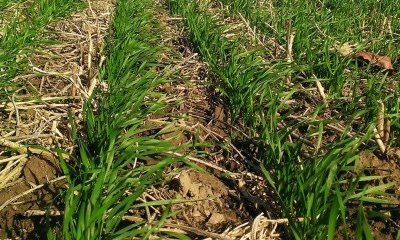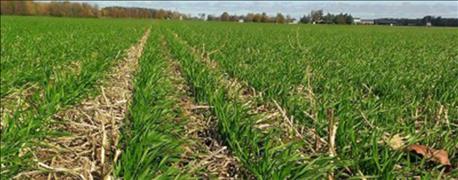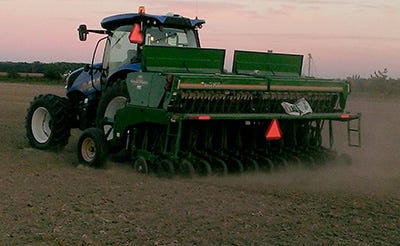September 14, 2016

Much of wheat’s yield potential is determined at planting. To attain top yields, measures need to be taken to plant early and achieve an even and uniform stand of seedlings.
Planting date

Planting the 2017 winter wheat crop
Early planting contributes significantly to improved yields. This was demonstrated a year ago when not only were there many fields planted during September, but warm weather allowed wheat to develop late into the fall, leading to well-developed root systems and tillers. Generally, beginning in mid- to late September, potential wheat yields slip at least 1 bushel for every day planting is delayed. This relationship does not hold once the calendar reaches late October as soil and weather conditions tend to play a more important role.
While the Hessian fly no longer poses a significant threat to wheat in Michigan, the fly-free-date is still a useful reference. Generally speaking, the fly-free-date is during the first week of September in northern Lower Peninsula, around mid-September in mid-state areas, and the third or fourth week of September for southern Michigan. Highest yields are often attained when seeding approximately five to 15 days following this fly-free-date. This timely planting helps insure that seedlings have sufficient time to develop an extensive root system and initiate multiple tillers before winter. Where wheat is planted before or within a few days following the fly-free-date, growers should significantly lower seeding rates and decrease or eliminate the use of nitrogen fertilizer at planting.
Seeding depth

Attaining a consistent depth, and thus even emergence, is often more critical than fine-tuning actual seeding depth. Usually, a planting depth of 1 to 1.5 inches is sufficient. Shallower plantings may emerge more quickly, whereas more deeply placed seed has the advantage of additional protection against winter stresses. An adjustment should be made where a field is exceptionally dry. In this case, the seed should be placed as deep as necessary to find moisture.
Planting rate
Michigan State University Extension’s recommendation is to plant between 1.4 and 2.2 million seeds per acre. Seeding rates on the lower end of the range should be reserved for fields being planted within a couple weeks of the Hessian fly-free-date. Using high seeding rates are discouraged when planting relatively early, as it may give overly thick stands for winter dormancy and eventually lead to plant lodging. As the calendar advances, seeding rates should become progressively higher. If planting continues into the second half of October, the seeding rate should be increased to at least 1.8 million seeds per acre. The seeding rates should also be adjusted upward when seed is of questionable quality.
Fall fertilization
University bulletins usually recommend 10 to 30 pounds per acre of fertilizer nitrogen in the fall. However, some observers find that little or no nitrogen fertilizer is necessary where seedings are made on a timely basis on moderately textured soils.
Phosphorus rates should be determined using soil test results. (See MSU Extension bulletin E2904, “Nutrient Recommendations for Field Crops in Michigan,” for more information.) Usually, soils having phosphorus levels of 50 ppm (100 pounds per acre) do not require additional fertilizer phosphorus. In general, soils having medium test levels of phosphorus (25-40 ppm) require approximately 50 pounds per acre of phosphate for a 90-bushel yield goal. Ontario researchers report they see a yield response to placing phosphorus in the row at planting. While Michigan has not demonstrated this placement response, this can be a very efficient practice.
Potassium fertilizer is usually broadcast applied in the fall. The actual rates are dependent on soil test levels, soil cation exchange capacities and yield potentials. For soils testing medium for potassium (75 to 100 ppm), approximately 100 pounds per acre of potash may be sufficient.
Nagelkirk writes for Michigan State University Extension
About the Author(s)
You May Also Like




